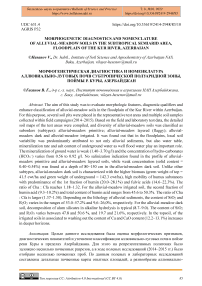Morphogenetic diagnostics and nomenclature of alluvial-meadow soils in the subtropical semiarid area, floodplain of the Kur river, Azerbaijan
Автор: Hasanov Vilayat
Журнал: Бюллетень науки и практики @bulletennauki
Рубрика: Сельскохозяйственные науки
Статья в выпуске: 10 т.8, 2022 года.
Бесплатный доступ
The aim of this study was to evaluate morphologic features, diagnostic qualifiers and enhance classification of alluvial-meadow soils in the floodplain of the Kur River within Azerbaijan. For this purpose, several soil pits were placed in the representative test areas and multiple soil samples collected within field campaigns (2014-2015). Based on the field and laboratory test data, the detailed soil maps of the test areas were compiled, and diversity of alluvial-meadow soils was classified as suborders (subtypes): alluvial-meadow primitive; alluvial-meadow layered (flaggy); alluvial-meadow dark and alluvial-meadow irrigated. It was found out that in the floodplains, local soil variability was predominantly attributed to not only alluvial sediments, but also water table, mineralization rate and salt content of underground water as well flood water play an important role. The mineralization of ground water is weak (1.40-3.70 g/l) and the concentration of hydro-carbonates (HCO3-) varies from 0.56 to 0.92 g/l. No salinization indication found in the profile of alluvial-meadow primitive and alluvial-meadow layered soils, while weak concentration (solid content = 0.40-0.54%) was found at a depth of 80-150 cm in the alluvial-meadow dark soil. Unlike other subtypes, alluvial-meadow dark soil is characterized with the higher biomass (green weight of top = 41.5 cwt/ha and green weight of underground = 142.3 cwt/ha), high mobility of humus substances with predominance of the 1st fraction of humin (20.0-28.1%) and fulvic acids (14.6-22.3%). The ratio of Cha : Cfa reaches 1.18-1.32. For the alluvial-meadow irrigated soil, the second fraction of humin acid (9.3-10.2%) and total content of humin acid ranges from 45.6 to 50.3%. The ratio of Cha : Cfa is larger (1.37-1.50). Depending on the lithology of alluvial sediments, the content of SiO2 and R2O3 varies in the ranges of 53.0-57.2% and 9,6-26,0%, respectively. For the alluvial-meadow dark soil, decomposition of alum silicates in alkaline hydrolysis is typical (8.7-9.0). The content of SiO2 and R2O3 varies between 47.8 and 50.6 %, and 19.7 and 21.6%, respectively. In the topsoil, of the irrigated soils in associated to washing out the content of Ca and CaO content (12.2-13.1%) increases in deeper horizons.
Soil, carbonates, soil profiles, alluvial soils, humus, groundwater, floodplains
Короткий адрес: https://sciup.org/14126122
IDR: 14126122 | УДК: 631.4 | DOI: 10.33619/2414-2948/83/10
Список литературы Morphogenetic diagnostics and nomenclature of alluvial-meadow soils in the subtropical semiarid area, floodplain of the Kur river, Azerbaijan
- Bernal, D. D. (1956). Nauka v istorii obshchestva. Moscow. (in Russian).
- Vladychenskii, S. A. (1955). Pochvenno-meliorativnaya kharakteristika Volgo-Akhtubinskoi poimy i volzhskoi del'ty: avtoref. diss. ... d-ra biol. nauk. Moscow. (in Russian).
- Dobrovol'skii, G. V. (1968). Pochvy rechnykh poim tsentra Russkoi ravniny. Moscow. (in Russian).
- Kovda, V. A. (1946). Protsessy pochvoobrazovaniya v del'takh i poimakh rek. Problemy sovetskogo pochvovedeniya, 14. (in Russian).
- Gasanov, V. G. (2004). Ideya V. A. Kovdy ob izuchenii genezisa i evolyutsii poimenno-allyuvial'nykh pochv sukhikh subtropikov Azerbaidzhana. In Materialy nauchnoi sessii po fundamental'nomupochvovedeniyu, Moscow. 138-139. (in Russian).
- Gasanov, V. G. O., & Ismailov, B. N. O. (2016). Morfogeneticheskaya diagnostika i nomenklatura allyuvial'no-lugovykh pochv Ganykh-Agrichaiskoi doliny. Vestnik Ryazanskogo gosudarstvennogo agrotekhnologicheskogo universiteta im. PA Kostycheva, (2 (30)), 12-18. (in Russian).
- Gasanov, V. G., & Ismailov, B. N. (2017). Vliyanie orosheniya na morfogeneticheskie pokazateli allyuvial'no-lugovo-lesnykh pochv Kuba-Khachmazskogo massiva Azerbaidzhana. Sibirskii vestnik sel'skokhozyaistvennoi nauki, 47(2), 105-113. (in Russian).
- Volobuev, V. R. (1965). Geneticheskie formy zasoleniya pochv Kura-Araksinskoi nizmennosti. Baku. (in Russian).
- Gasanov, V. G. (2004). Pochvy poim i nizinnykh lesov Azerbaidzhana. In Morfogeneticheskieprofilipochv Azerbaidzhana, Baku, 112-132. (in Azerbaijani).
- Hasanov, V. H. (2010). Genetic Features and Diagnosis of Alluvial-Meadow Soils in Flood-Lands of the Khura River. Annals of Agrarian Science, 5(1), 61-63. (in Azerbaijani).
- Babaev, M. P., Gasanov, V. Kh., Dzhafarova, Ch. M., & Guseinova, S. M. (2011). Morfogeneticheskaya diagnostika, nomenklatura i klassifikatsiya pochv Azerbaidzhana. Baku. (in Azerbaijani).
- Egorov, V. V., Fridland, V. M., & Ivanova, E. N. (1977). Klassifikatsiya i diagnostika pochv SSSR. Moscow. (in Russian).
- World reference base for soil resources. Rome: FAO, 2014.
- Shishov, L. L. (2004). Klassifikatsiya i diagnostika pochv Rossii. Smolensk. (in Russian).
- Kovda, V. A. (1973).Osnovy ucheniya o pochvakh. Moscow. (in Russian).


